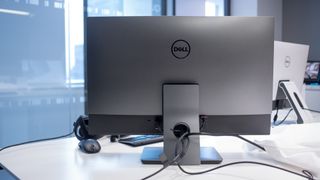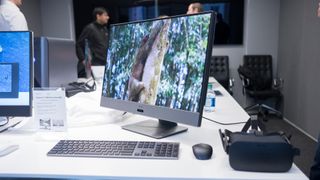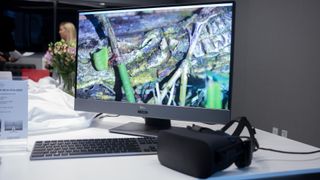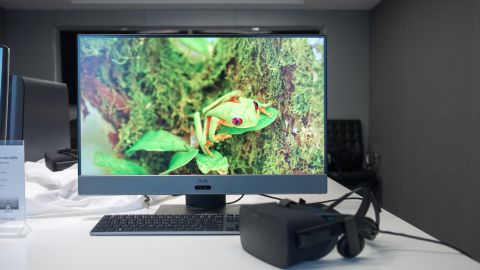Early Verdict
The Inspiron 27 7000 is quite the impressive everyman machine, with the tools necessary to handle hefty work (and play) loads in a presentation almost anyone can understand.
Pros
- +
Gorgeous 4K display
- +
Smart cable management
- +
Ready for VR
Cons
- -
Can’t be upgraded much
Why you can trust TechRadar
In just its first year of existence within public reach, virtual reality has become the biggest buzzword in the computing world bar none, and Dell has obviously noticed. The firm’s latest attempt to get VR into the mainstream is the Inspiron 27 7000 all-in-one desktop.
A 27-inch PC housing a Dell’s first InfinityEdge screen on an AIO as sharp as 4K (3,840 x 2,160), the Inspiron 27 7000 includes your choice of AMD Ryzen 5 1400 or Ryzen 7 1700 processors as well as either Radeon RX560 or RX 580 Polaris graphics chips.
Both drives offer up to 32GB of RAM and spinning hard drives as large as 1TB as well as solid-state boot drive combos up to 256GB PCIe SSDs. Starting at $999 (about £779, AU$1,345), this latest Inspiron looks to bring VR to more sorts of folks than just gamers.

Design
With an ostensibly family-friendly, crowd-pleasing appearance, the Inspiron 27 7000 serves both as a computer for all sorts of folks and a vessel to get said folks into virtual worlds. To bridge that gap, however, an optional 4K HDR10 display with incredible color reproduction will have to do.
The Inspiron 27 7000’s metallic back panel is removable for easier upgrades to storage and RAM, and the sturdy, angular stand has some smart cable management tools.
Dell also equipped this AIO with an infrared camera for Windows Hello login on Windows 10, for the simplest form of secure login around: your face.
As for connectivity, Dell outfitted the Inspiron 27 7000 with four USB 3.1 ports, two USB 2.0 ports, one USB Type-C port and two HDMI ports (one out; one in) for easy VR setup. Dual-band AC Wi-Fi and Bluetooth 4.1 round out the wireless connectivity options.
The included wireless mouse and keyboard are just fine, but nothing terribly effective or egregious either way. The travel and feedback are about as deep and punchy as you’d fine on an Inspiron laptop, well meeting standards.

Paving the way for near-ubiquitous VR
Dell’s deeper motive with the Inspiron 27 7000 is to entice general customers into the world of VR. While the device costs a grand to start, it’s more about the form factor of such an approachable, familiar PC bringing that technology forth than anything.
While Oculus Rift and HTC Vive should work just fine with this Inspiron, but the upcoming Dell head-mounted display should pair even better when it (hopefully) lands later this year.
Unfortunately, we weren’t able to test the model’s VR performance, but a unit equipped with the desktop-grade Radeon RX580 should be more than enough to handle VR games and movies. Ultimately, Dell’s plan to normalize VR makes sense, and we’d like to see it work out if for anything to see VR be enjoyed by more than just gamers.

Early verdict
Dell’s first Inspiron all-in-one with its InfinityEdge display impresses while staying within its price confines, confidently adopting all-AMD technology to bring VR to more types of computer users than before. This is an AIO as ready for you and family to watch 4K movies on as it is ready for you to get some Overwatch in on.
That’s before even getting the VR implications, positioning the Inspiron 27 7000 as quite the impressive everyman machine, with the tools necessary to handle hefty work (and play) loads in a presentation almost anyone can understand. Stay tuned to see how the all-AMD hardware holds up in a full review.
Joe Osborne is the Senior Technology Editor at Insider Inc. His role is to leads the technology coverage team for the Business Insider Shopping team, facilitating expert reviews, comprehensive buying guides, snap deals news and more. Previously, Joe was TechRadar's US computing editor, leading reviews of everything from gaming PCs to internal components and accessories. In his spare time, Joe is a renowned Dungeons and Dragons dungeon master – and arguably the nicest man in tech.
What is a hands on review?
Hands on reviews' are a journalist's first impressions of a piece of kit based on spending some time with it. It may be just a few moments, or a few hours. The important thing is we have been able to play with it ourselves and can give you some sense of what it's like to use, even if it's only an embryonic view. For more information, see TechRadar's Reviews Guarantee.


